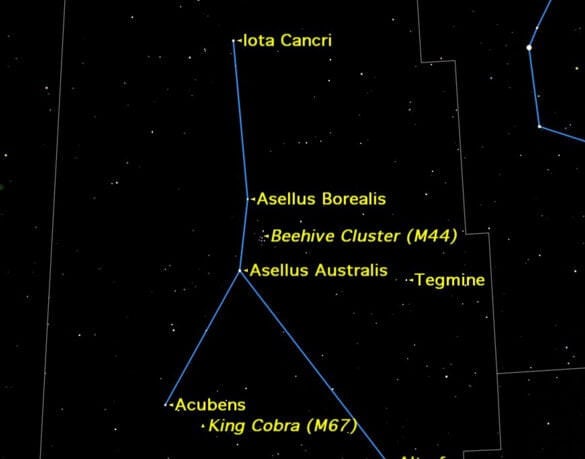
Spotting the Cancer constellation in the night sky can be a challenging task since it consists of only a handful of dim stars.
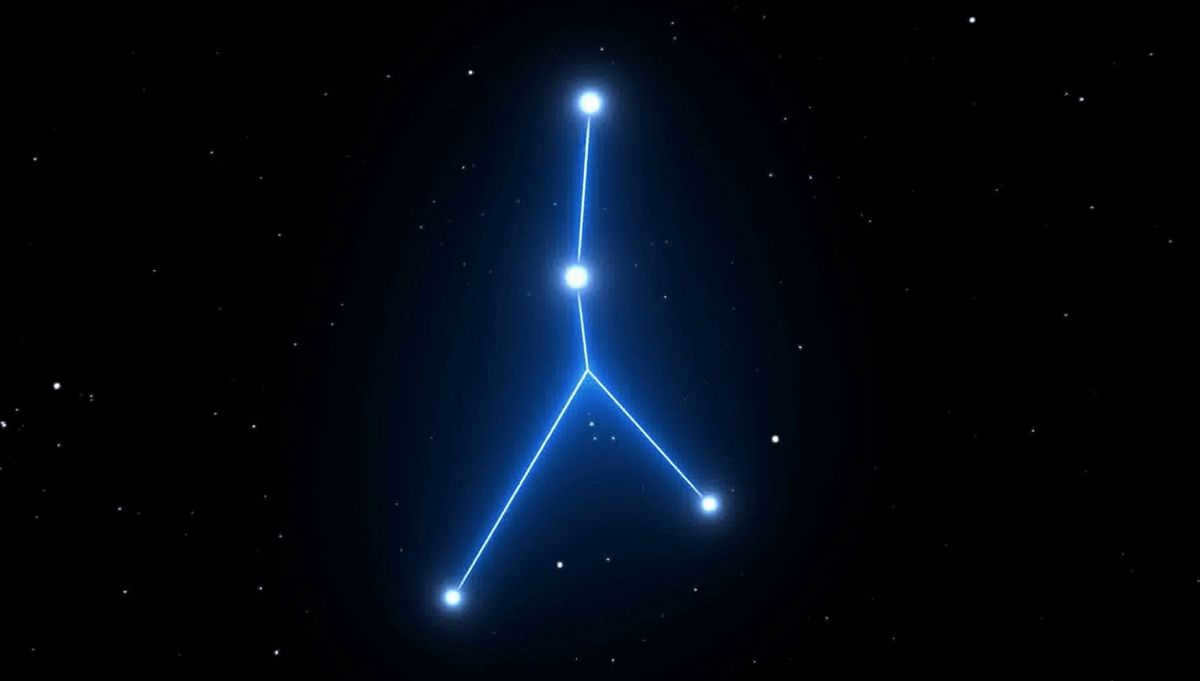
However, there is no reason to disregard this particular constellation: it contains unique celestial entities that pique curiosity. For instance, are you interested in discovering the distance one must traverse to reach the “diamond planet”?
Indeed, there is much to be said about this constellation. Did you know that the scarab, turtle, and the Cancer constellation share a common trait? And what connection does this constellation have with the tropics? What role do the donkeys play in this constellation? How does Hercules intertwine with it? Lastly, what is this ancient object, dating back 4 billion years, that captivates the attention of astronomers?
What does Hercules have to do with it?
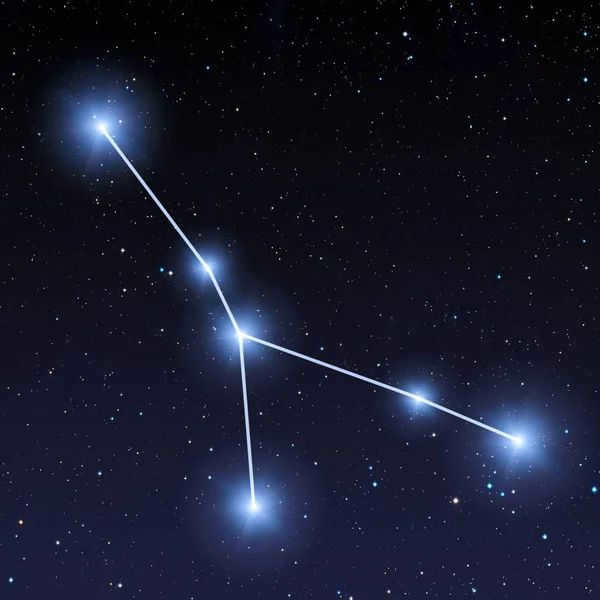
Similar to many other constellations, this celestial figure possesses a designation bestowed upon it by the ancient Greeks. The Greeks had a penchant for immortalizing the heroes of their myths in the stars. However, what caused the ordinary river crayfish to achieve such fame?
According to the legends, the narrative unfolds as follows. Heracles embarked on yet another extraordinary endeavor – to confront the Lernaean Hydra.
Meanwhile, the goddess Hera, who harbored animosity towards the hero due to his status as a illegitimate son of her husband Zeus, dispatched a crayfish to latch onto Heracles’ leg with its pincers, diverting his attention from the battle and preventing him from emerging victorious. Nevertheless, Heracles delivered such a forceful kick to the arthropod that it was propelled into the sky, where it remained.
There exists an alternate version of this myth: it is said that Heracles, overcome with anger, simply trampled the crab. Subsequently, Hera, as a reward, resurrected the deceased crustacean and elevated it to the heavens.
Crustacean, Beetle or Reptile?
The arrangement of stars in the constellation of Cancer resembles the letter “lambda” (λ) from the ancient Greek alphabet. Three beams radiate outwards from the central point, where the Delta star of Cancer (the vibrant orange giant known as Azellus Australis) illuminates the night sky. In ancient Greek mythology, one of these rays was perceived as the body of a crab, while the remaining two were regarded as its pincers.
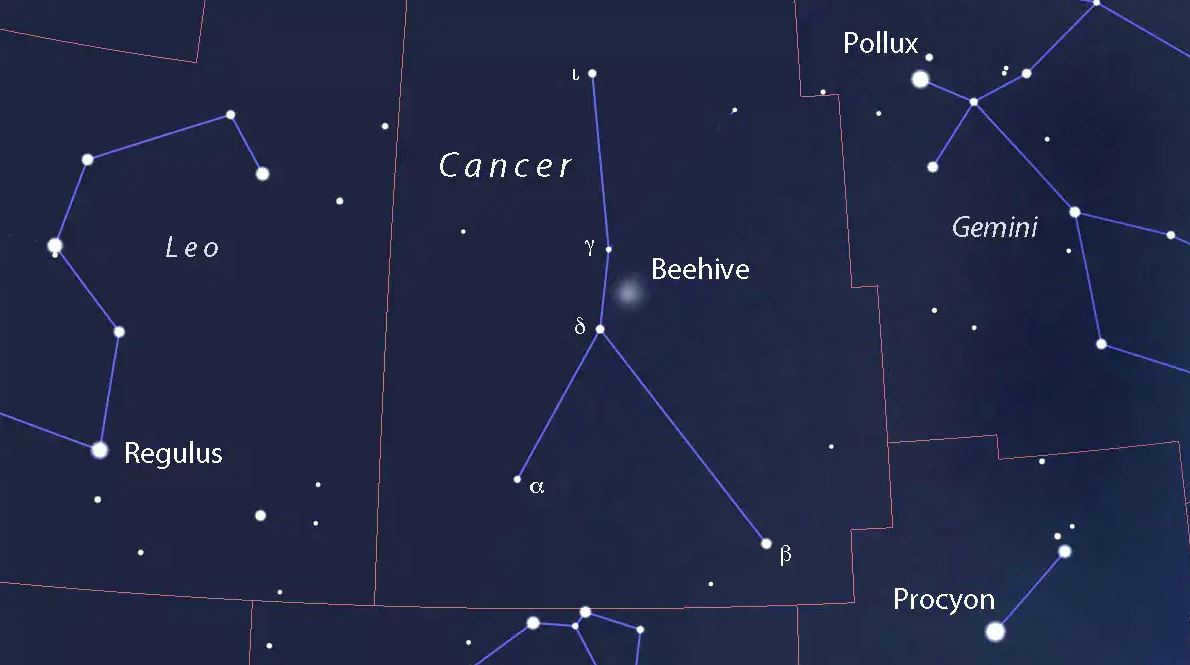
However, there are alternative names for this constellation:
- The ancient Egyptians believed that this celestial figure represents the sacred beetle known as the scarab. It is also strikingly similar: two rays extending from the “body” in this case symbolize the beetle’s jaws.
- Chinese astronomers associate the objects in this constellation with the Red Bird of the South.
- According to one theory, the ancient Greeks, who were skilled sailors, believed that this constellation resembles a sea crab.
- In ancient Babylon, this figure was also recognized in the sky, but it was referred to as the Turtle.
Where are the Donkeys hiding in the constellation?

There is a fascinating mix of “animal” names in this constellation. It may seem strange to associate donkeys with cancer, but the central star of the constellation, Delta of Cancer, is actually named Azellus Australis, which translates to Southern Donkey in Greek. And nearby, we have Azellus Borealis, the Northern Donkey, also known as Gamma of Cancer.
Despite being referred to as Donkeys due to their relatively dim brightness from Earth, these stars are actually stellar behemoths. Delta Cancer is an orange subgiant, and Gamma Cancer is a complex system of five stars, with a hot white subgiant leading the way.
There are multiple stars (three or more) that appear so closely aligned to an observer on Earth that they seem to blend together. As a result, they are perceived as a single visual entity, despite actually being separated by hundreds or even thousands of light years.
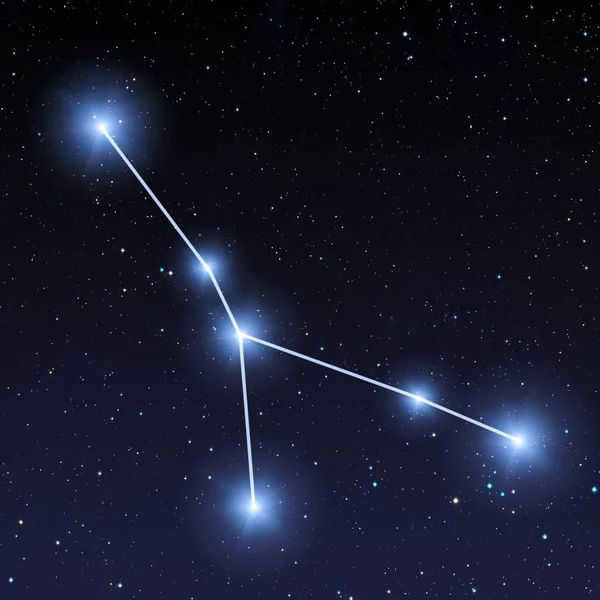
There are also numerous systems in which stars are gravitationally bound together. The gamma of Cancer is classified as an optical phenomenon, meaning it is a “celestial illusion”. Nonetheless, astronomers hypothesize that there is still one companion star gravitationally linked to the white subgiant.
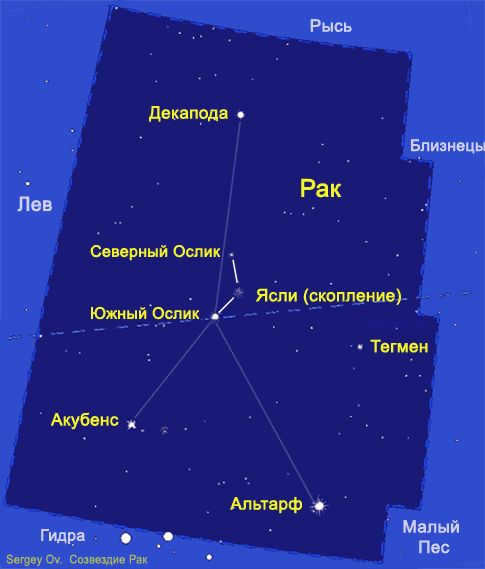
But why do these stars have the name of donkeys? Once again, let’s go back to the Greek myths. During a fierce battle between the Olympian gods and titans, Hephaestus and Dionysus appeared riding on donkeys.
The titans had never encountered these creatures before and were filled with fear. Thus, the “donkeys” played a role in the victory over the Titans. As a reward, Dionysus sent them to the heavens.
And not far from the Donkeys, there is another celestial object associated with them by name. It is the Crèche, a star cluster located 577 light-years away. This cluster consists of over a thousand stars, which, to an observer from our planet, appear to merge into a single entity. For a long time, this cluster was mistaken for a nebula.
The Nursery is one of the nearest star clusters to Earth. This cluster also goes by another name: The Hive.
Just to clarify, “nursery” does not refer to a junior group in a kindergarten. In this context, it actually refers to a feeder for donkeys. So the names make perfect sense in this case.
Which stars shine the brightest in this nursery?

Despite being the first letter of the Greek alphabet, the brightest star in the Cancer constellation is not Alpha. In fact, it is only the fourth brightest star in this celestial figure.
This particular classification system was proposed by astronomer Johann Bayer in 1603 when he created the star atlas Uranometria Omnium Asterismorum. This system gained popularity and is widely used in science. Originally, Bayer intended to assign letters to stars in descending order of brightness, but he deviated from this principle himself. As a result, there are many exceptions on the celestial map.
Delta, situated in the center of the constellation, is not the most luminous star in Cancer. The brightest star in Cancer is Beta, with a magnitude of 3.5. It is important to note that we are referring to the apparent magnitude of stars as observed from Earth.
Apparent magnitude refers to how bright a celestial object appears to the human eye (represented by the letter m). It is distinct from absolute magnitude. For instance, a supergiant star that is thousands of light-years away from Earth and shines thousands of times brighter than the Sun would appear faint to us.
On star charts, the constellation Cancer typically consists of five stars:
All these stars are relatively dim: the visible brightness of Beta is just 3.5 m – which is not very high, and the other stars are even fainter. As a result, identifying the Cancer constellation in the night sky is not a simple task.
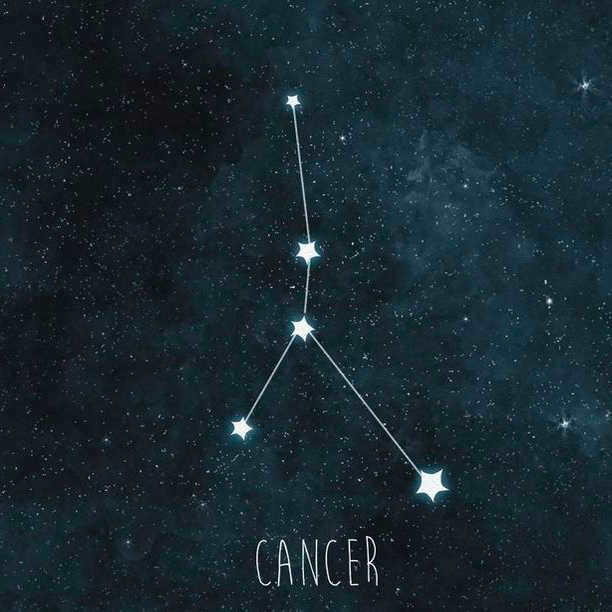
There are a total of 104 stars in the constellation that have a brightness exceeding 6.5 meters, making them visible to the naked eye.
The brightness of a star, as perceived by an observer, is inversely proportional to its apparent magnitude. A lower magnitude indicates a brighter star, while a higher magnitude indicates a dimmer one. As a result, Beta Cancer, with an apparent magnitude of 3.5 m, appears brighter to us than Alpha Cancer, which has a magnitude of 4.6 m.
What is the meaning of the Tropic of Cancer?
Chances are, you’re familiar with this phrase – perhaps due to its association with Henry Miller’s renowned novel, which was adapted into an equally renowned film. But what exactly does it signify?
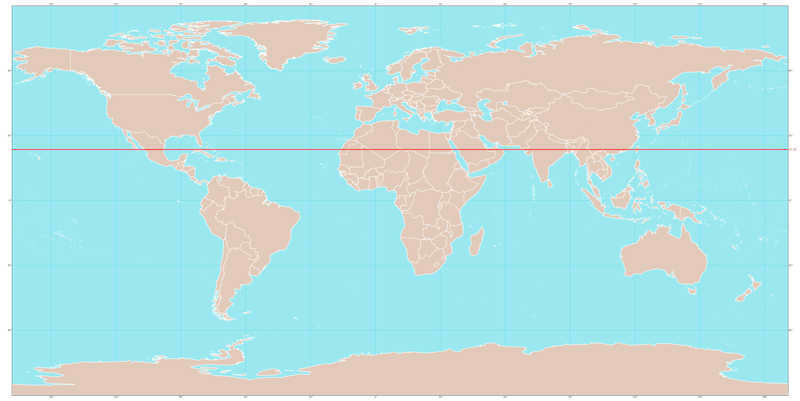
The Cancer constellation is home to a unique diamond planet, and here are seven intriguing questions that will give you answers about it.
Located in the northern hemisphere, the Tropic of Cancer marks the northernmost latitude where the Sun is directly over the observer’s head during the July solstice. At latitudes further north, the Sun does not reach its zenith during the solstice due to the planet’s tilt in relation to the Sun.
Below the Tropic of Cancer lies the tropical zone, while above it is the subtropical zone. The Tropic of Cancer is also known as the Northern Tropic. In the southern hemisphere, the equivalent line is called the Tropic of Capricorn.
Which celestial body in the constellation is more than 4 billion years old?
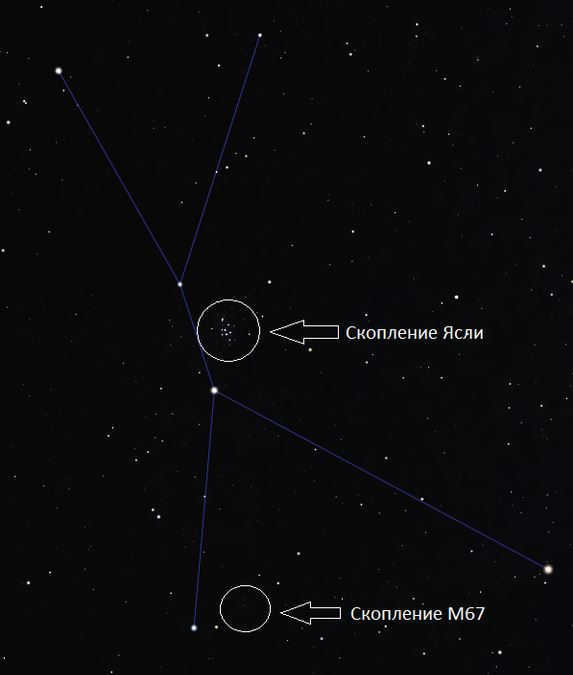

This ancient object is not a star, but a complete cluster of stars known as Messier 67 (M 67), which comprises around five hundred luminaries. The reason is that constellations are not solely composed of stars. Astronomers include other celestial objects as well, including those outside our Galaxy.
M 67, like the nursery, belongs to star clusters. However, it is much more distant than Yasleys – located 2,500 light years away from Earth.
There are also other remarkable objects within the Cancer constellation.
Among the most intriguing of these:
- The remarkably beautiful, jewel-like spiral galaxy NGC 2775 (also known as Caldwell-48);
- There are a few more spiral galaxies – NGC 25Z5 and NGC 25Z6, which have caught the attention of astronomers due to their gravitational interaction with each other;
- A couple of supernovae (one exploded in 1920, while the other, by historical standards, occurred fairly recently – in 2001);
- A beautiful spiral galaxy with a junction – NGC 2608;
- Stars that occasionally flare up and experience dramatic changes in intensity.
Are there any planets orbiting the stars in this constellation?
Within this constellation, there are multiple star systems that contain their own planetary systems. A few of these systems can be found within the Crèche cluster. However, the most fascinating discovery is the planet Janssen, which is in orbit around the star 55 Cancer. Janssen is classified as a super-Earth due to its mass, which is eight times greater than that of Earth and comparable to the mass of Neptune. This star system is located 40 light years away from our own solar system.
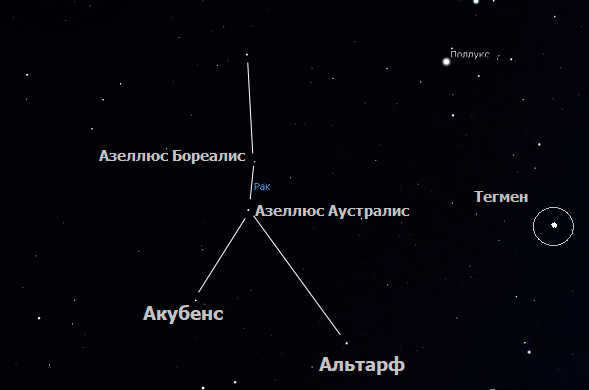
There is no presence of life, specifically protein-based life, on this particular planet: the temperature on its surface surpasses 3,000 º C. Researchers are currently engaged in intense discussions about Janssen: one hypothesis suggests that this planet contains a substantial amount of carbon, causing it to transform into a colossal supermass due to immense pressure. This is why Janssen is occasionally referred to as the “diamond planet”.
The best time to make observations is during the months of January and February.
The Cancer constellation is one of the zodiac constellations, meaning that the Sun passes through its region in the sky for a certain period of time. This occurs between July 21 and August 9.
To locate the Cancer constellation, it is easiest to first locate the constellations of Gemini and Leo. The Cancer constellation will be situated between these two constellations and the Capricorn constellation.
Scientific Facts Video Review
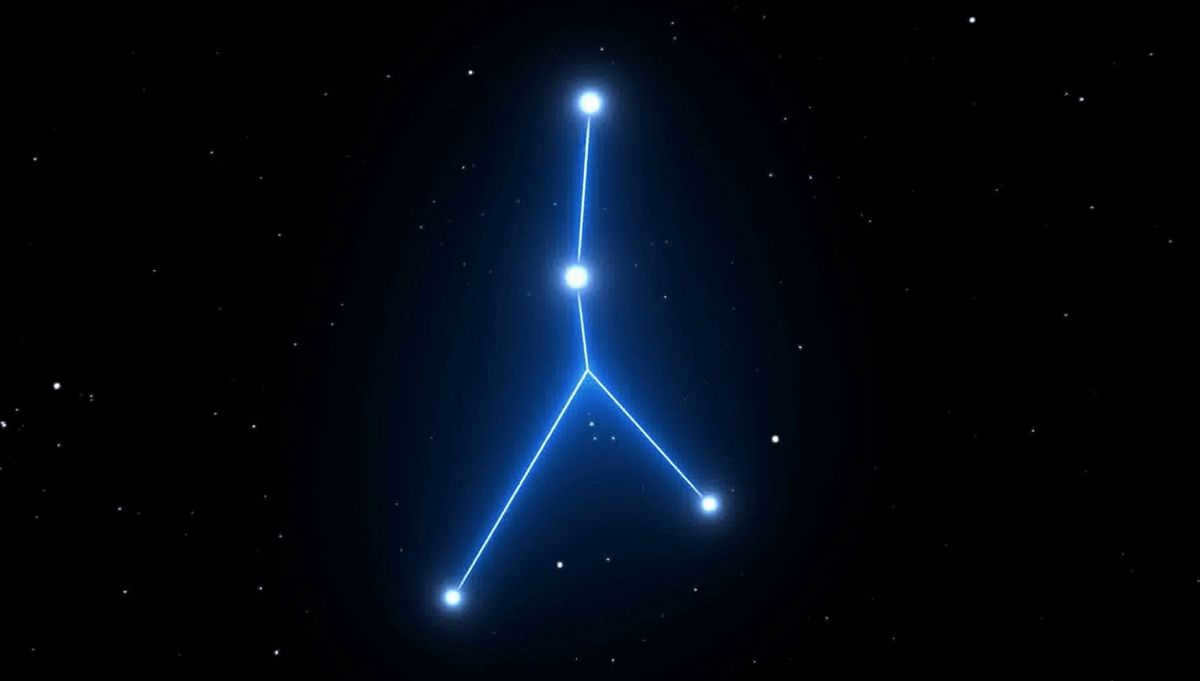
The zodiacal constellation Cancer is relatively inconspicuous in the vastness of outer space. Special equipment is desirable to observe it, and only on a clear night can the cluster be seen with the naked eye. However, astronomers have no difficulty studying this celestial formation, and as a result, they have gathered a wealth of fascinating information about it.
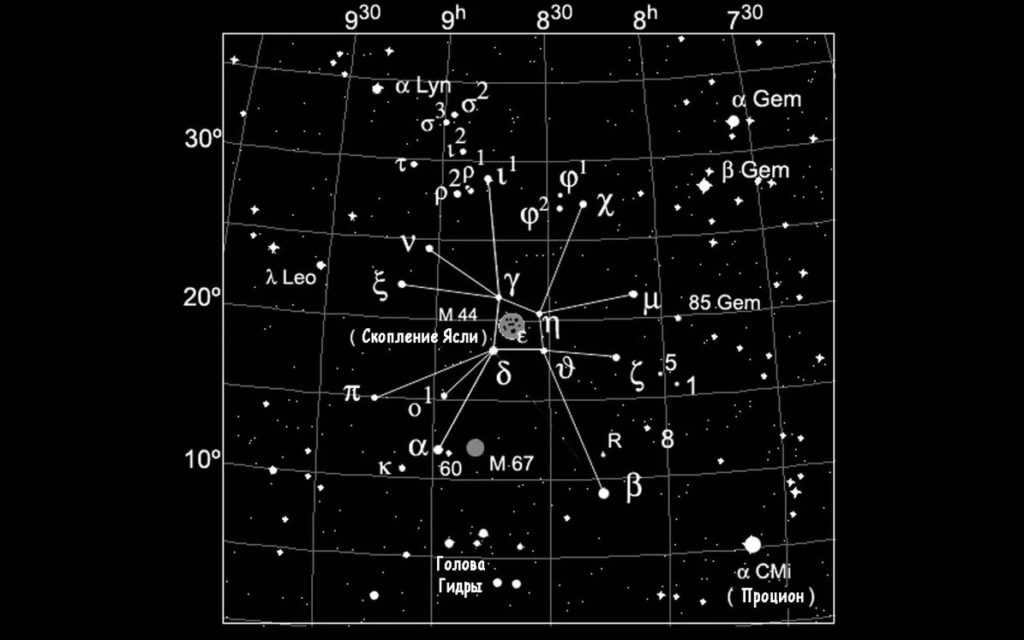
This particular group of stars is not listed among the larger constellations and is ranked only 31st in terms of size. It covers an area of approximately 506 square degrees. To locate it, one must direct their attention to the second quadrant as observed from the northern hemisphere. The Cancer constellation is positioned within latitudes ranging from -60 to +90 degrees. Nearby constellations include Lynx, Little Leo, Hydra, Little Dog, Leo, and Gemini.
Did you know? The most prominent star in this constellation has a magnitude of 3.53, making it appear relatively dim compared to the other stars.
When looking at a map of this constellation, two large star clusters can be observed: M67 and the Nursery. These clusters are accompanied by two stars that have planets orbiting around them. Additionally, there is a meteor shower known as the Delta Cancrids that can be seen between these celestial objects.
Distinctive features of the zodiac sign Cancer
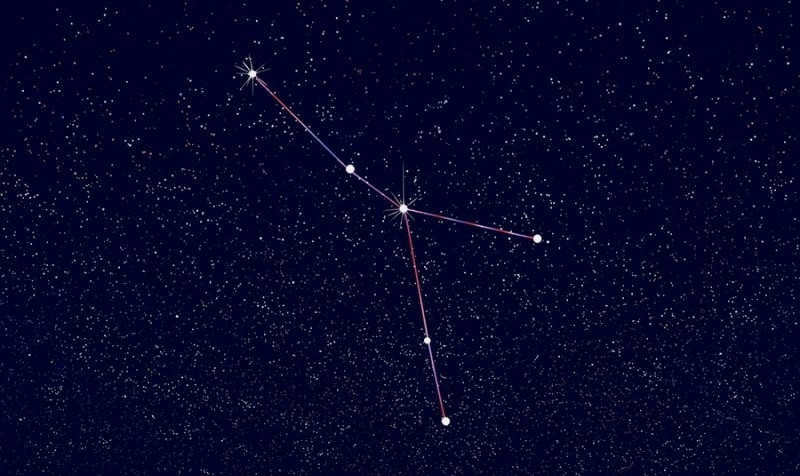
Similar to other constellations, Cancer has been extensively studied by astronomers who have established certain parameters. However, these parameters are periodically refined and updated with new information. Currently, the characteristics of this constellation are as follows:
- The Latin name for Cancer is Cancer, and its abbreviation is Cnc;
- The symbol representing Cancer is Cancer;
- The right ascension of Cancer can be observed from 7:48 a.m. to 9:15 a.m.;
- The declination of Cancer ranges from +7 degrees to +33 degrees 30 minutes;
- The area covered by Cancer is 506 square degrees;
- The brightest star within the constellation is Altarf;
- There are meteor streams known as Delta Canciridae;
- The exact coordinates of the constellation lie between latitudes -56 degrees and +90 degrees;
- The constellation Cancer can be easily spotted in the sky during the months of January and February.
These distinguishing features make it convenient for researchers to locate and study this constellation in the sky.
A popular misconception regarding the constellation Cancer
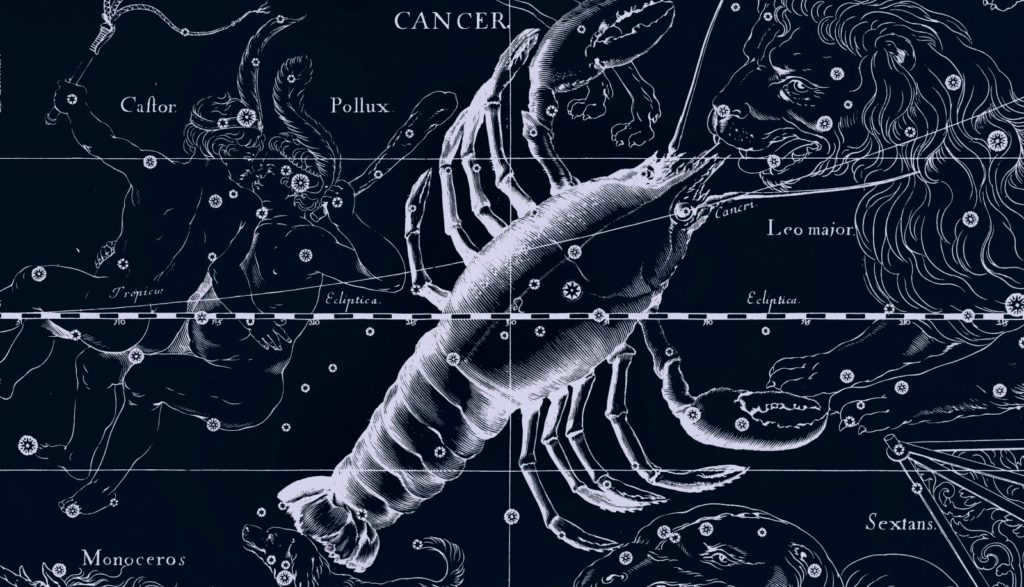
Ever since its discovery in ancient Greece, the constellation Cancer has been accompanied by a fascinating myth that explains its origin. During a battle with the Lernaean Hydra, Heracles quickly realized that he was facing a formidable opponent. To gain an advantage, the Hydra enlisted the help of the crab, hoping to distract the demigod and seize the opportunity to strike.
Did you know? The Lernaean Hydra is a massive creature with multiple heads that emit toxic fumes.
The entity came closer to its objective and made an attempt to grasp his Achilles’ tendon. Nevertheless, Heracles promptly retaliated and delivered such a powerful blow to the crustacean that it soared into the heavens, undergoing a metamorphosis into a group of stars.
The principal celestial bodies adorning the Cancer constellation
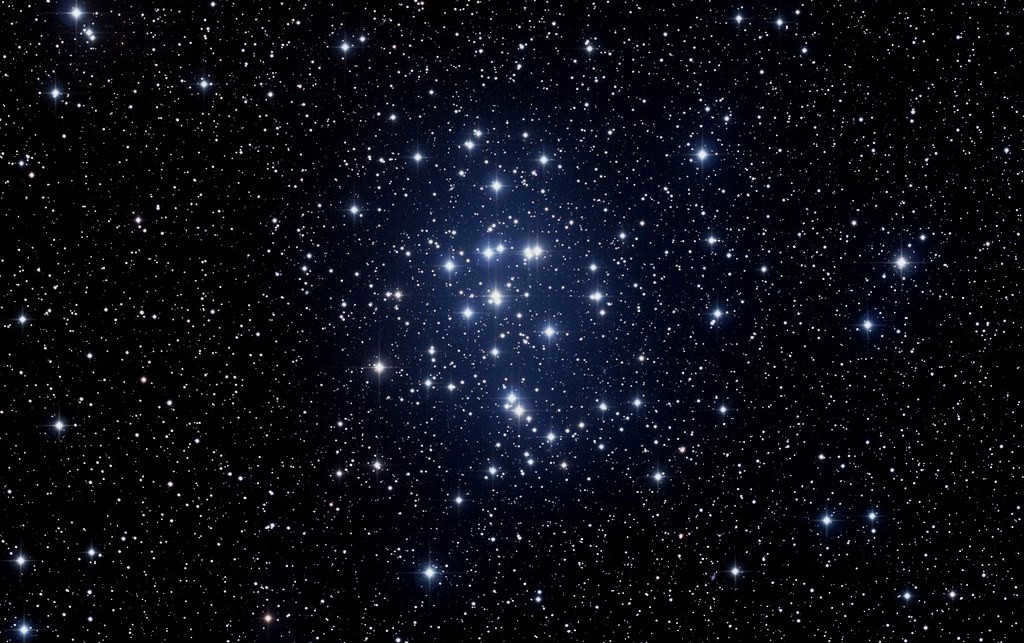
Because Cancer is a relatively small constellation in the vastness of space, it doesn’t have a large number of stars. However, astronomers have already identified the key stars that serve as markers for locating the cluster:
- Acubens. This star is located 174 light-years away and is considered the alpha star of the Cancer constellation. Acubens is 23 times brighter than the Sun, making it quite luminous. There are certain times of the year when it is hidden behind the Moon, making it impossible to observe. In ancient times, Arab astronomers referred to this star as the “claws”.
- Altarf. Beta Cancer is a binary star system consisting of a giant star with an orange glow and its companion. These two stars together have a combined brightness of 3.5, making Altarf the most prominent star in the cluster.
- Azellus Australis. A massive orange star, four times larger than the Sun, is classified as a delta. It is positioned 180 light-years from Earth and is considered the second brightest star in the constellation. Additionally, it is a member of the Creche cluster.
- Azellus Borealis. This star has the ability to be concealed by the Moon during specific periods. It is identified as a white subgiant situated 158 light-years away. Furthermore, it holds the status of being the Gamma of Cancer. According to myth, Borealis is believed to be the donkey upon which one of the gods rode into battle against the Titans.
- 55. This celestial object consists of two dwarf stars. Despite being only 41 light-years away, it remains invisible to the naked eye and requires a telescope with substantial magnification to be observed. Additionally, this system is home to five orbiting planets.
- Tegmin. It is composed of four stars and is the zeta of the constellation. The system has an orbital period of 17 years.
- Lambda. It is one of the farthest stars from the solar system: it takes 419 years for light from the white dwarf to reach Earth. The visible magnitude of the object is 5.92 m.
- Xi. It consists of a yellow giant and its companion, located 381 light-years away.
Interesting fact: The star Azellus Australis was referred to as “Arkushanangarushashutu” by the Babylonians. This translates to “The star of the constellation Cancer, located in the southeast” and is considered the longest name of a celestial object.
The Cancer constellation is composed of numerous stars, but most of them have low brightness, which is why they are rarely observed by astronomers.
Celestial bodies in the constellation of Cancer
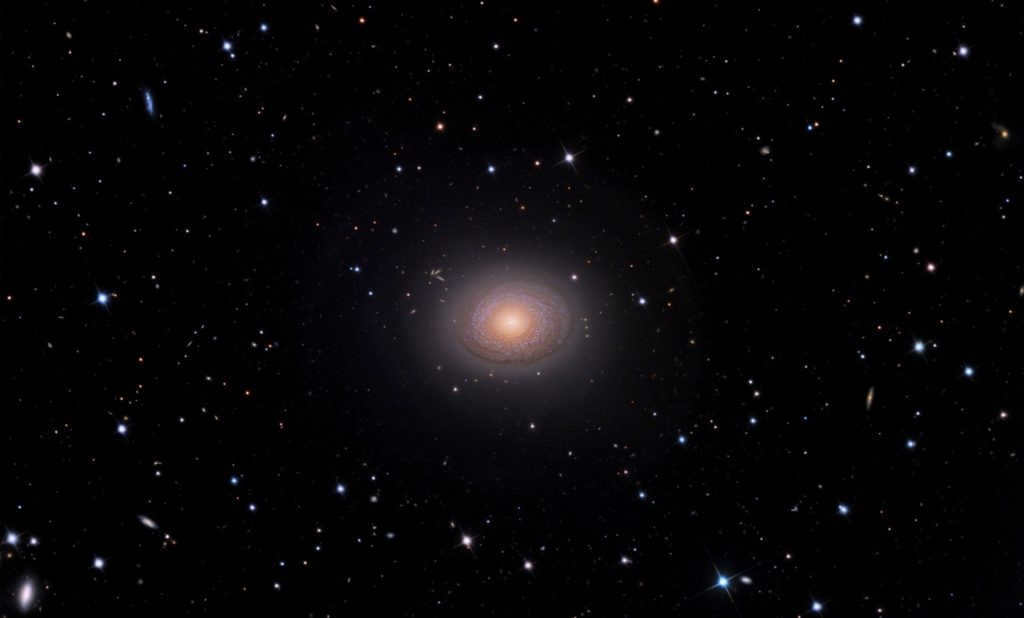
Within the Cancer constellation, astronomers regularly observe a variety of objects that are highly intriguing for scientific exploration. Currently, it is feasible to compile an inventory of celestial bodies possessing distinctive characteristics:
- The Stellar Nursery. Positioned 577 light years away from Earth, this star cluster is estimated to be more than 600 million years old, making it relatively youthful in cosmic terms. Comprising over a thousand luminaries, approximately two-thirds of them are dwarfs while the remaining fraction bears resemblance to our Sun. The objects’ brightness varies between magnitudes 6 and 6.5. The stellar nursery is readily discernible to the unaided eye, which explains its discovery in ancient times. Ptolemy was the first to provide a comprehensive description and catalog of these entities.
- Caldwell-48. A galaxy with a spiral shape located approximately 56 million light-years away from our solar system. The galaxy’s arms are positioned around a bright core. It is comprised of numerous stars and planets.
- NGC 2535 and 2536. These two galaxies are situated in close proximity to each other, resulting in mutual influence.
- NGC 2500. A spiral-shaped galaxy located 33 million light years away. It was first discovered in the 18th century and was initially assigned to the constellation Lynx.
- NGC 2608. This galaxy spans a length of 62,000 light-years. Its structure undergoes regular changes as its arms rotate around the central region. Astronomers periodically observe the emergence of supernovae and other celestial objects within NGC 2608. It is situated at a distance of 92 million light years.
Fascinating fact: The Moon periodically causes many objects that are part of the constellation to “disappear.” Astronomers then have to patiently wait for them to reemerge into the open space.
The constellation Cancer is a subject of great interest for study. It comprises both ancient and relatively young objects, combining together to form a cohesive image that contributes to our understanding of the cosmos and its structure.
Observing the process of locating it in the celestial sphere
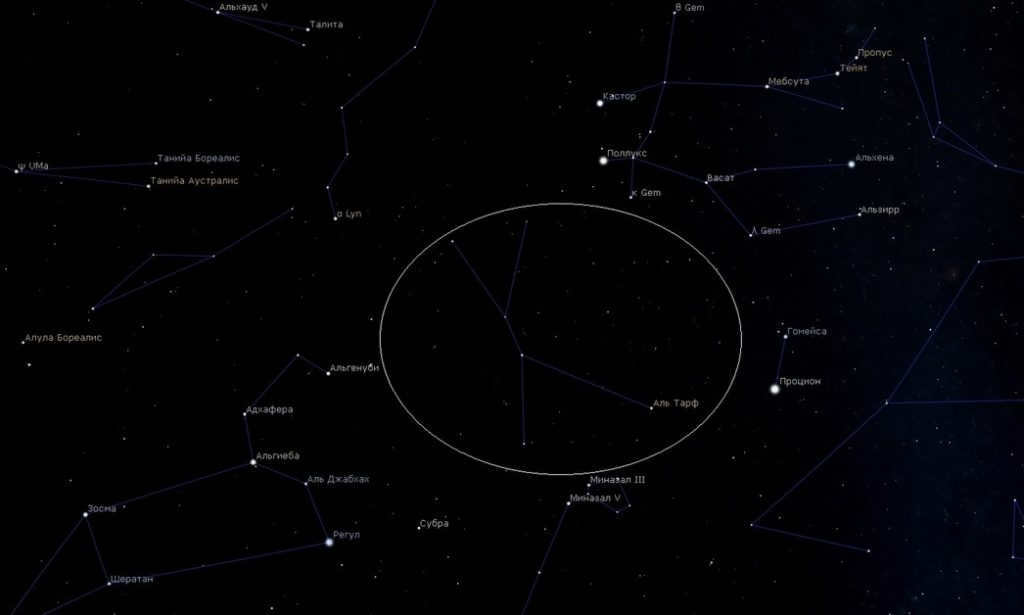
Observing the constellation Cancer in the night sky can be a challenge due to its lack of brightness. To spot it, it is recommended to use binoculars for better visibility. It is also advisable to venture outside city limits where the light pollution from streets and lampposts can obstruct the view of the stars.
To locate Cancer, one should look towards the south where the constellations Gemini and Leo are situated. Cancer can be found nestled between these two constellations. By using binoculars, you will easily spot Akubens, the brightest star within Cancer. For viewers in the Russian Federation, the winter months provide the best opportunity to observe this cluster.
Origin of the name
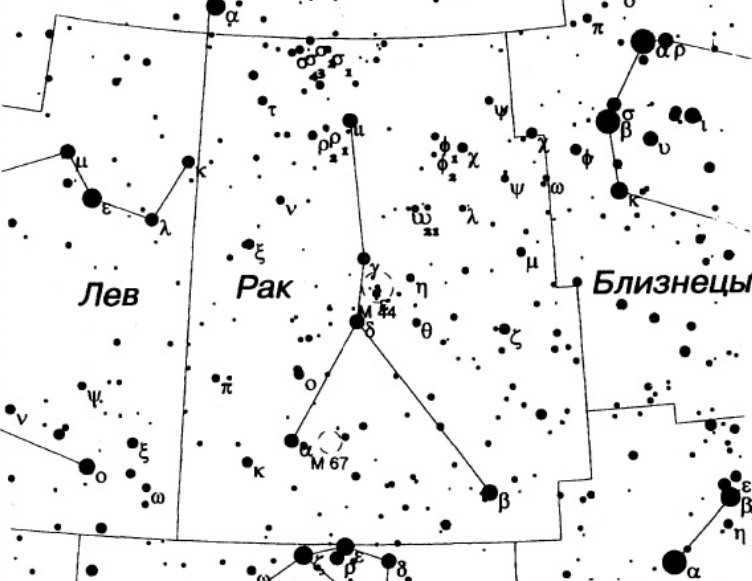
The origin of the name of this constellation is closely tied to the myth surrounding its creation. When the cluster was initially observed and documented by the ancient Greek astronomer Ptolemy, he employed the use of gods and mythical creatures to aid in the classification and identification process, assigning their names to the newly formed star map.
The glyph representing the zodiac sign Cancer – 69

It is common knowledge that the constellation Cancer is represented by the number “69”. The symbol is depicted with a slight rightward tilt. This representation is relatively new, as the ancient Greeks used to draw an actual crab to depict the constellation on celestial maps. However, due to the time-consuming nature of drawing a crab, a simplified version, 69, was later invented. The symbol can have different meanings and interpretations depending on the context. There are several main interpretations of its meaning:
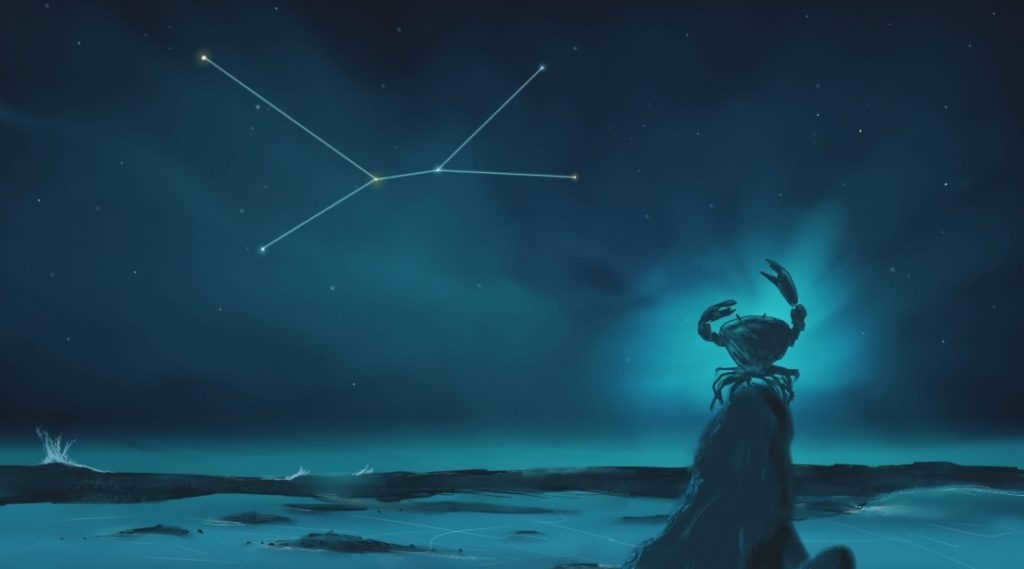
Astrologically, the Cancer constellation period begins on June 22 and ends on July 22. Individuals who are born during this time are assigned to this zodiac sign. From July 21 to August 9, the Sun is located in the Cancer cluster area.
People who fall under this sign are often possessive and have a strong inclination towards taking care of their family and loved ones. Their character can contain contradictory qualities. For instance, Cancers can effortlessly achieve professional success through hard work, but in their leisure time, they tend to be exceptionally lazy.
Individuals born under this astrological sign possess a continuous capacity for acquiring valuable lessons from past experiences and accumulating wisdom. This acquired knowledge serves as a guide for avoiding mistakes in the future and enhancing their overall life circumstances.
Fascinating fact: The ruling planet of the Cancer sign is the Moon, which happens to be the Earth’s satellite. It is widely believed that the Moon exerts a significant influence on individuals born under this sign. This is not surprising considering that numerous celestial objects are concealed behind this celestial body.
When it comes to selecting a life partner, Cancer individuals may not always act with complete sincerity. They may choose to enter into a committed relationship solely based on a person’s financial status. However, they are also capable of experiencing profound grief and sorrow when faced with the loss of their loved one.
If you come across any mistakes, kindly select the specific text and hit Ctrl+Enter.
The Cancer constellation, though its stars may appear faint when compared to the surrounding brighter constellations, conceals numerous enigmas and boasts incredibly unique celestial entities. Locating them can be quite challenging, as if a celestial crustacean is evading scrutiny. However, this makes the exploration of this region of space even more captivating for the observant stargazer.
The placement and nomenclature of the Cancer constellation
The Cancer constellation is part of the second quadrant of the northern hemisphere of the sky (NQ2). It is made up of five major stars and several smaller ones. It resembles a crayfish or a crab. This association has been known since ancient times in Mesopotamia. However, in the ancient East, the constellation was also known by other names. The Babylonians called it the tortoise, the Assyrians called it the bull, and the Egyptians called it the scarab. Sometimes, instead of the Cancer figure, a simpler figure was recognized, consisting of two stars and a bright nebula between them. This figure was called the Donkey or Donkey’s Manger. The stars now known as Delta and Gamma of Cancer represented the donkeys, and the nebula represented a trough with hay. It is likely that the Donkey’s Manger asterism is even older than Cancer itself.
The ancient Greeks named the star figure Cancer, and according to their mythology, it represents the mythical crab that tried to impede Heracles in his battle against the Hydra at the behest of the cunning Hera. This asterism was mentioned as Cancer by the ancient Greek scientist Euktemon in 430 BC and later included in the “Almagest” in 140 AD. Ptolemy, in his influential work “Almagest,” described the constellation Cancer, which consisted of 9 stars, including the Crèche asterism. This depiction of the celestial figure became a classic as the Almagest served as the primary guide for observers for the next 1,500 years. Subsequent atlases consistently portrayed the constellation Cancer as a river arthropod, although some also included a crab, such as in Bayer’s “Uranometria.”
The arrangement of the Cancer constellation in the celestial map
The International Astronomical Union officially established the boundaries of the Cancer constellation on the celestial map in 1930. These boundaries form a nearly perfect rectangle, with the northern, southern, and eastern sides being straight lines, while the western side is made up of seven segments. This encompasses not only the well-known asterism, but also the surrounding space. The total area covered by the Cancer constellation is 506 square degrees, making it the 31st largest out of the 88 constellations.
In this region, the unaided human eye can discern 112 celestial bodies ranging from 6.5 to 3.6 stellar magnitude (based on the 5th edition of the Yale Bright Star Catalog). However, optimal sky conditions are necessary for this observation. The majority of stars appear dim and are obscured by the glare of urban lighting. Nonetheless, with the aid of high-quality optical instruments, one can observe a plethora of captivating entities. These include extraordinary multiple and variable stars, systems housing exoplanets, remarkable galaxies, one of the oldest known (M67) in the cosmos, and one of the nearest star clusters to Earth (M44, commonly known as the Nursery).
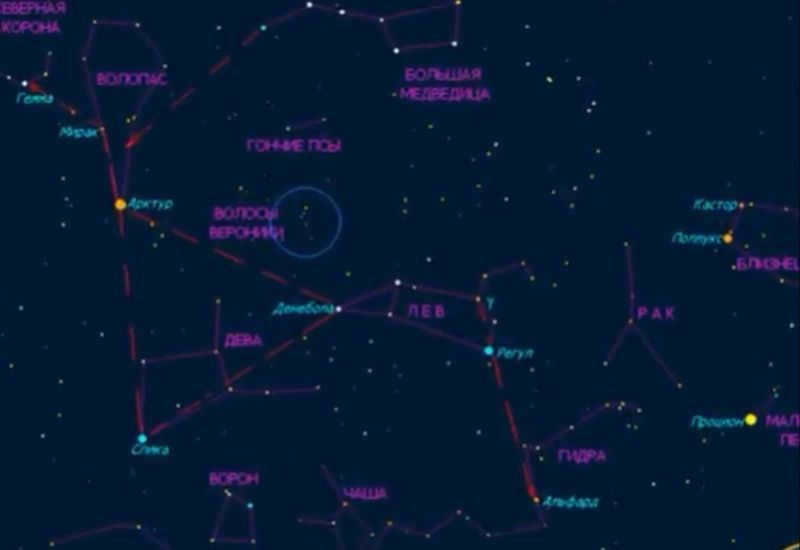

The Cancer constellation shares its borders with five other celestial neighbors: to the west is Gemini, to the north lurks Lynx, in the northeast shines Little Leo, to the east shines Leo, in the south wriggles Hydra, and in the southwest shines Little Dog, the faithful assistant of the celestial hunter Orion.
In the second equatorial system, the position of the constellation is defined by the following coordinates: right ascension – from 7:48 to 9:15, declination – from +7 deg. 00 min. to +ZZ deg. Z0 min.
The constellation of Cancer can be seen in its entirety at latitudes ranging from the North Pole to the 60th parallel south. As a result, it is visible in all parts of Russia. The celestial figure is highest above the horizon in January, with the best observation conditions occurring from January to April. The Sun is in Cancer from July 21 to August 9.
The asterism that corresponds to the meteor stream of medium intensity, Delta Cancirida, can be observed from December 14 to February 14. The peak of this meteor shower falls between January 1 and January 24.
Guide on Locating the Cancer Constellation in the Night Sky
If you want to spot the Cancer constellation in the night sky, the simplest way is to direct your attention towards the prominent stars of the neighboring celestial formations. Begin by identifying the well-known stars Castor and Pollux in the Gemini constellation, and then proceed to locate Regulus in Leo. In the space between these stars, you will find the sought-after Cancer constellation. This stellar pattern is recognized for its distinctive shape resembling an inverted letter “Y” in the Latin alphabet.
The constellation’s most fascinating stars are Acubens and Altarf, also known as Alpha and Beta. These stars are intriguing multiple systems, and in the vicinity of 55 Cancer A, astronomers have discovered five exoplanets. Additionally, it is highly recommended to direct our attention to the elements of the ancient asterism known as “Donkeys and Nursery” – Delta and Gamma of Cancer. Let us examine them more closely.
Acubens: The Fourth Brightest Star in Cancer Constellation
Acubens, also known as Alpha of Cancer, is not the most luminous star in the constellation. It ranks as the fourth brightest, with an apparent magnitude of 4.20. Located at the tip of the southern claw of the celestial figure, it is alternatively referred to as Akubens (meaning “claw” or “claws” in Dravearabic) or Sartan (“crab”).
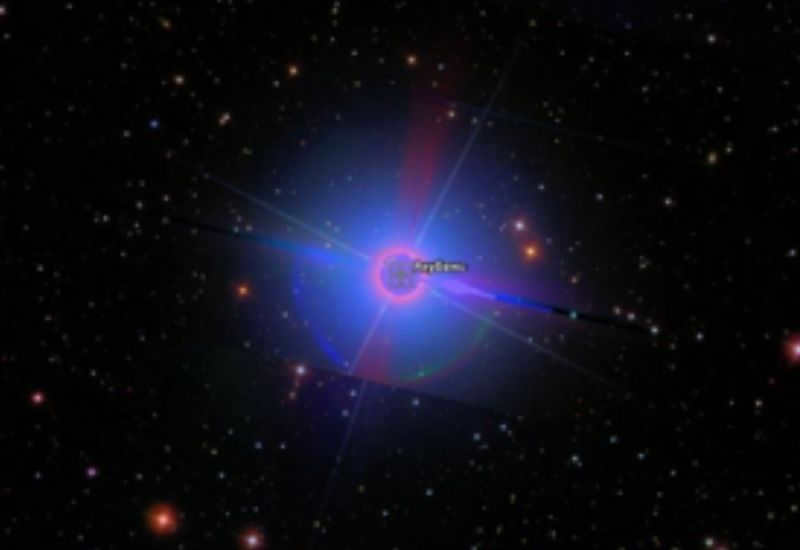
Located 164-174 light-years away from Earth, the object is a fascinating multiple system. Its primary companion is a hot white star with a visible magnitude of 4.6. It is renowned as one of the most well-known representatives of Am-type stars, which, in comparison to typical A-class stars, exhibit a significantly higher concentration of elements beyond hydrogen and a particularly abundant presence of metals such as iron, nickel, zinc, strontium, zirconium, and barium in their atmospheres. This phenomenon is believed to be attributed to both genuine disparities in the chemical composition of these objects and the peculiarities of their rotation. The slower rotation, combined with the tidal influences from its partner luminary, leads to the accumulation of certain elements in the stable outer layers of the Am star.
Acubens A clearly exhibits these characteristics. Its partner is a star with an apparent magnitude of 11th. The orbital period of the two stars is around 6.1 years. There are indications that there might be a third star in the system, even more closely associated with Acubens A.
Altarf, also known as β Cancer (Beta Cancer)
Beta Cancer, with an apparent luminosity of 3.5, shines as the most brilliant object in the asterism. Its proper name, Altarf (Tarf), derives from the Arabic word for “edge” or “tip,” indicating its position within the asterism: Beta Cancer completes the right (northern) claw of the Cancer constellation. Additionally, the name is occasionally interpreted as “the eye of the Lion.” This reference points to the ancient Arabic constellation of Leo, which encompassed a greater area than the present-day constellation and included a portion of the Cancer region. As a star located near the celestial equator, Beta Cancer held significance for all civilizations. It continues to captivate modern researchers with its intriguing properties.
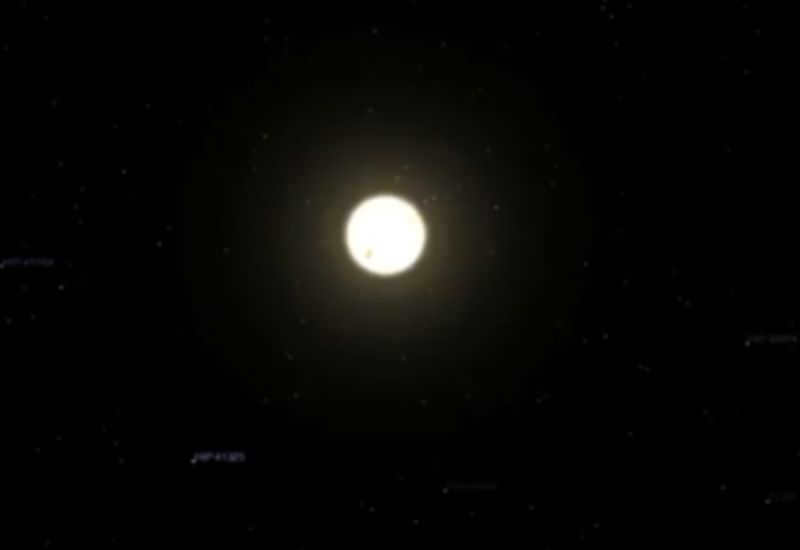
Astronomers have discovered a binary star system situated 290 light years away from Earth. The system is composed of a large orange giant star classified as a K4III and a faint red dwarf star. These two stars are separated by a distance of 2600 astronomical units or 29 angular seconds. The stars have a mutual rotation period of 76 thousand years.
One reason why Altarf A has gained increased attention is the recent discovery of its exoplanet, Beta Cnc b. This celestial object, which has a mass 7.8 times that of Jupiter, completes a full orbit in approximately 605 days. The shape of its orbit is nearly circular. Despite being 1.7 astronomical units away from the star, the planet’s surface is significantly heated due to the star’s high luminosity. As a result, Beta Cnc b is classified as a “hot Jupiter”. The exoplanet was first detected in 2014 by scientists at South Korea’s Pohyongsan Observatory using the radial velocity method. This method involved analyzing 85 measurements of the exoplanet’s motion.
Azellus Australis or δ Cancer (Delta Cancer) – The Shining Star
Delta Cancer, also known as δ Cancer, is the second brightest star in the constellation of Cancer. With a visual magnitude of 3.94, it is easily visible even in urban areas with light pollution. This star is located at the head of a celestial arthropod, and it is also a part of the asterism known as the Donkey. Interestingly, the star’s name translates to “Southern Donkey.” Just above the Donkey, you can find the beautiful cluster of Crèche (M 44), making Delta Cancer a valuable guide for locating it. Additionally, this star is in close proximity to the radiant of the Delta Cancers meteor shower.
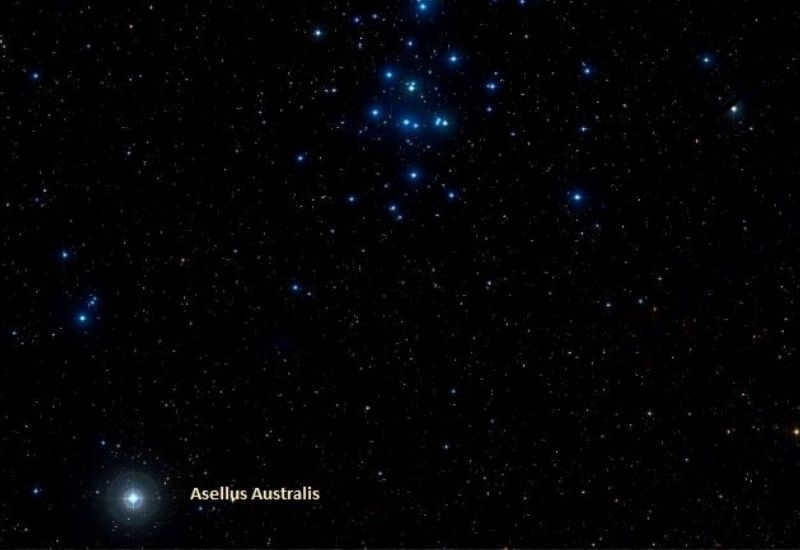
In terms of its physical characteristics, Delta Cancer is a massive star categorized as a K0 III spectral class, featuring a vibrant orange surface hue. Having already departed from the main sequence, this celestial body has initiated the process of “burning” helium within its core, resulting in a significant expansion to a diameter of 11 times that of our Sun. With a mass surpassing that of our own star by 1.7 times and a radiation intensity exceeding it by 52 times, Delta Cancer exhibits impressive luminosity. Despite its grandeur, this giant star possesses a relatively low surface temperature of 4637 K. Having been in existence for approximately 2.5 billion years, Delta Cancer is speculated to have a dimmer companion star, with an apparent luminosity of 12.2.
The celestial body known as Azellus Borealis or γ Cancer (Gamma Cancer)
Gamma Cancer can be found in the central region of the arthropod-shaped constellation. It is also a constituent of the asterism Donkey and Nursery, where it represents the “Northern Donkey”. This is the translation of its official name. The apparent magnitude of this star is 4.65.
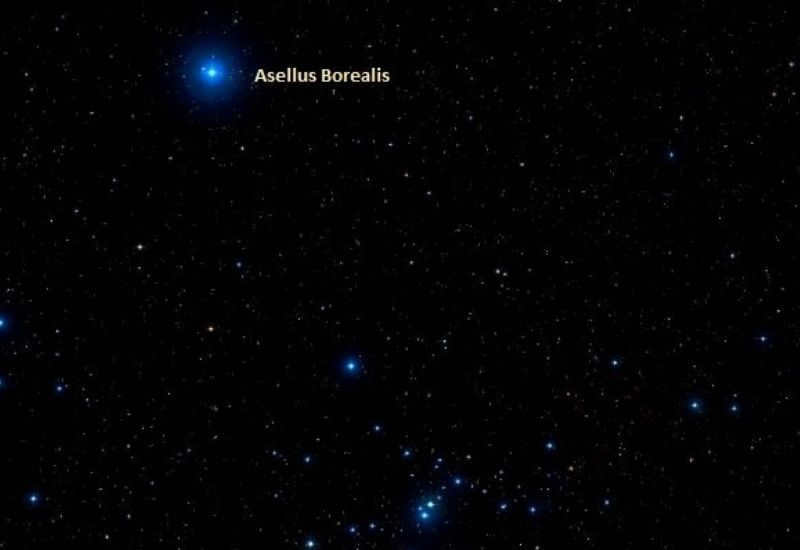
The Gamma Cancer is classified as an A1IV subgiant, located approximately 181 light-years away from our solar system. It features a brilliant white surface and emits a scorching temperature of around 9108 K. With a size and mass that are twice as large as the Sun, this star shines 36 times more intensely. Gamma Cancer has entered a brief evolutionary phase, characterized by the burning of hydrogen in the outer shells of its core. Moreover, it possesses two optical companions that appear close in its line of sight.
This small star with a magnitude of 5.95, which can be seen with the naked eye, is situated just to the left of Iota Cancer, near the asterism’s “tail”. It has gained recognition as one of the most fascinating systems containing exoplanets.
The star itself is a physical double. The main object (55 Cancer A) is a yellow dwarf of the G8V spectral type. In terms of its parameters, it bears resemblance to our own sun. Its radius is 0.943, its mass is 0.95, and its luminosity is 0.6 solar. It is notable for its high metallicity. The second component of the pair (55 Cancer B) is located 1065 astronomical units away from the first and is a red dwarf of the M3.5-4V type. This system is situated 40.9 light-years away from us.
Exoplanets have been detected orbiting a star similar to our Sun, known as 55 Cancer A. This star is home to a total of 5 exoplanets, including 4 massive gas giants similar in size to Jupiter, and one planet with a mass similar to that of Neptune, which is believed to be a super-Earth. The discovery of this system set a new record for the most multi-planet system, surpassing the previous record held by Mu Sacristan with its 4 planets. It is important to note that there are likely many more systems like this, but our current instruments and methods are limited in detecting smaller planets located at great distances. Therefore, the study of 55 Cancer A and its exoplanets represents a significant breakthrough in our understanding of planetary systems.
While it is true that there are currently multiple recognized systems containing 5 or more planets (such as HD 10180 in Hydra, Kepler-11, and others), 55 Cancer A holds a unique position among them. Researchers are particularly intrigued by the opportunity to study the formation of planetary systems in stars similar to our own sun, and to explore the similarities and differences between these systems and our own.

The 55 Cancer A planetary system is unique in its composition, and there is a possibility that some of its planets could support life. Specifically, one of the massive planets is located in the habitable zone, also known as the Goldilocks zone. This particular planet may even have sizable rocky moons with a mass similar to Earth, complete with oceans and an atmosphere. It is conceivable that intelligent beings, similar to those we know, could potentially exist on these moons.
Super-Earth 55 Cancer A, also known as the planet-diamond, has a surface made of very hard carbon that makes it unsuitable for terrestrial life. The temperature on the day side of the planet can reach 1-1.5 thousand degrees Celsius due to its proximity to the star. However, it is possible that there is another planet in the system, similar to Earth, located in the “zone of life”. This planet has not been discovered yet because of its small size. Therefore, NASA considers 55 Cancer A as one of the most promising candidates for the search of such a planet.
To provide a more comprehensive understanding of the system, here are the key features of the confirmed planets:
- b – a celestial body weighing 0.78 times the mass of Jupiter, with a major semi-axis of its orbit being 0.115 astronomical units, and an orbital period of 14.7 days (discovered in 1996)
- c – a planet with a mass of 0.169 times that of Jupiter, located at a distance of 0.24 astronomical units from the star (discovered in 2002)
- f – a gas giant with a mass of 0.144 times that of Jupiter, orbiting the star at a distance of 0.73 astronomical units and completing its orbit in 260 Earth days (discovered in 2007)
- d – a planet weighing 3.835 times more than Jupiter, orbiting the star in an elongated orbit over a period of 12.4 years at a distance of 5.3 astronomical units
As the star 55 Cancer A gained popularity, the International Astronomical Union officially named it Copernicus in 2015. In 2003, a radio signal was transmitted to the star in search of possible extraterrestrial life. The signal is expected to reach its destination in May 2044.
Exploring Deep-Sky objects in the constellation Cancer
Discovering and observing Deep-Sky objects through a telescope can provide unforgettable experiences. Within the constellation Cancer, there are several fascinating clusters and galaxies worth exploring, including M44 (also known as The Nursery), M67, and the captivating NGC 2775 galaxy.
M44, also known as “The Hive,” is an intriguing star cluster that is situated relatively close to us, at a distance of only 550-600 light-years. This proximity allows astronomers to observe and analyze its many intricate details. It is particularly appealing to amateur stargazers due to its mesmerizing beauty and photogenic nature. With just a pair of binoculars, one can witness numerous bright stars, while a medium-sized telescope (50-100 mm) reveals around 1-2 hundred luminous points. Many of these stars possess a captivating warm golden-orange glow, while the brightest ones shine with a striking white-blue radiance, ranging from 6.0 to 6.3 magnitude. Collectively, these stars create a stunning spectacle in the night sky, resembling a swarm of enchanting fireflies or bees.
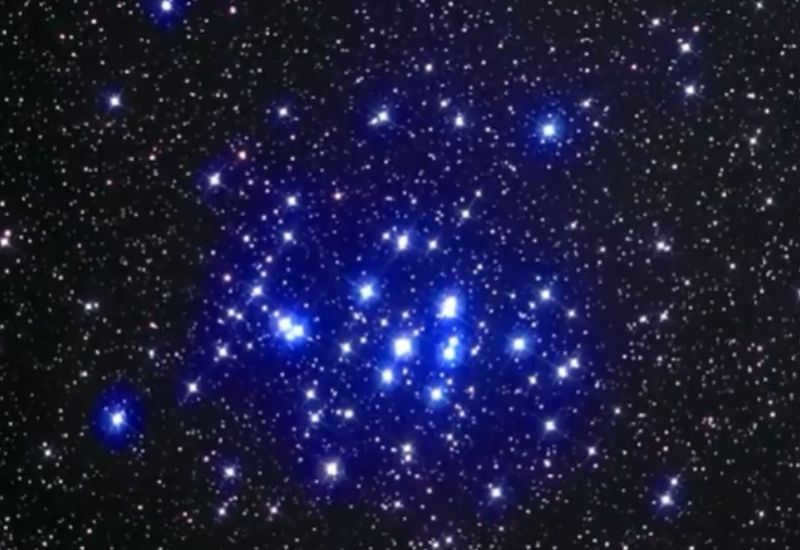
It is not possible to observe the individual stars with the naked eye, however, the cluster itself is easily noticeable in the dark sky as a circular “white cloud” positioned between the stars Gamma and Delta Cancer. The cluster has a visual stellar magnitude of 3.7 m and an angular size of 1.5 degrees. Our ancient ancestors associated it with a feeding trough filled with hay, with two starlings nearby. This is why it is also known as the Nursery, a name that has been used since ancient times in the Eastern civilizations and can be found in the writings of ancient authors from the 3rd and 4th centuries BC, such as Eudoxus and Aratus.
Today, advanced optical devices have enabled the enumeration of ten billion stars in the cluster. The most brilliant one is Epsilon of Cancer, boasting an apparent magnitude of 6.3 m. All of these celestial bodies are relatively young, having an age range of 600-730 million years. Among them, there are numerous massive giants that are undergoing rapid evolution and are on the verge of departing from the main sequence, with some already having achieved that. Additionally, several stars within the cluster have been discovered to be accompanied by exoplanets.
The star field stretches across a vast expanse of outer space, spanning a distance of 25-30 light years. It is speculated that these stars emerged from the same gas-dust cloud as the luminaries within the Hyades cluster.
Messier 67 (M67 or NGC 2682)
Messier 67, also known as M67 or NGC 2682, is a star cluster characterized by its diffuse appearance. What makes this cluster particularly fascinating is its age, as it is considered one of the oldest objects of its kind. Scientists estimate that Messier 67 is approximately 3.2-5.0 billion years old, making it roughly the same age as our Sun. Remarkably, it is also the closest old cluster to Earth, situated at a distance of 2930 light years. By studying M67, astronomers can deepen their understanding of stellar evolution and expand our knowledge of the universe.
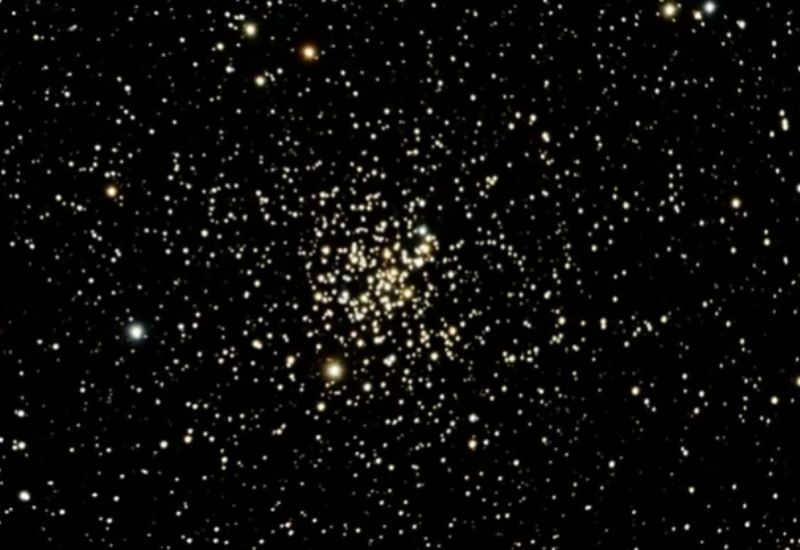
Within the cluster, there exists a collection of 500 luminaries. Although they all originated simultaneously, their individual initial masses have caused them to “exist” at varying speeds. Over half of these stars have already transitioned from the main sequence and transformed into red giants or white dwarfs. Of the remaining stellar bodies, 30 are classified as blue stragglers. The other stars retain a substantial supply of hydrogen fuel. Amongst them, there are 100 yellow and orange dwarfs that bear striking similarities in composition and age to our very own Sun. These particular objects captivate scientists due to their potential for harboring planetary systems and offer an opportunity for further exploration and investigation. However, as of the year 2022, only four stars within the M67 cluster have been found to possess planets. These planets are all classified as hot gas giants and orbit at low distances.
NGC 2775 (Caldwell 48).
NGC 2775 is a spiral galaxy with a distinct ring shape and a lack of connecting features. It is of considerable size and benefits from an advantageous orientation (at an angle of 44 degrees), which provides a clear view of its structure when observed with large instruments. On Hubble images, NGC 2775 appears particularly striking, with a prominent empty bulge and tightly wound spiral arms that exhibit a discontinuous pattern reminiscent of individual “flakes.” Among these dark bands of dust, millions of bright blue stars shine, creating a visual effect similar to the plumage of a bird or the swirling motion of a whirlpool. Astronomers have determined that star formation in the galaxy’s core has ceased, and there is now a scarcity of gas present.
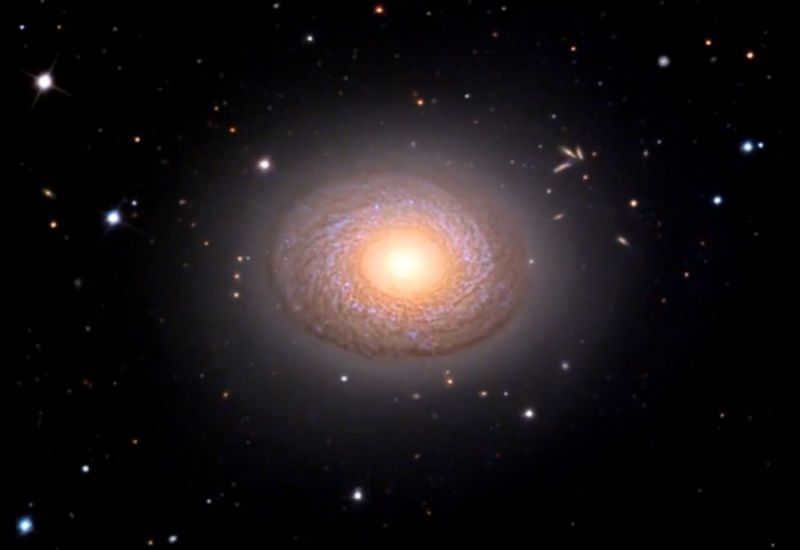
The galaxy is situated 67 million light years away from the Earth and spans across 80 thousand light years. Throughout its existence, it has managed to acquire two smaller satellites – NGC 2777 and UGC 4781. Together, they form a local group, which is named after the galaxy itself: the NGC 2775 group.
It has an angular size of 4.3 by 3.3 minutes of arc and a surface brightness of 11.2. For independent observation, it is recommended to employ a telescope with a large aperture – starting from 100 mm.

The name of the constellation Cancer is explained by a popular legend. Unfortunately, the ancient tales of the people of the Ancient East about this group of stars have not been preserved.
However, myths not only provide an explanation for the constellation’s origin, but also shed light on its significant role in the sky. This region is where the Sun changes its course, symbolizing the mystery of death and rebirth. Interestingly, there are very few stars in this area, creating a sense of a portal to other dimensions. It can be seen as the “gateway of the solar path,” through which souls enter this world. On the other hand, souls depart through another “gate” located in the constellation Capricorn.
Within the Christian faith, “Donkeys and the Creche” has acquired significant symbolism during the Christmas season. The Creche, where Mary tenderly laid the Infant, is represented by the nebula, while the donkeys rest faithfully beside it.
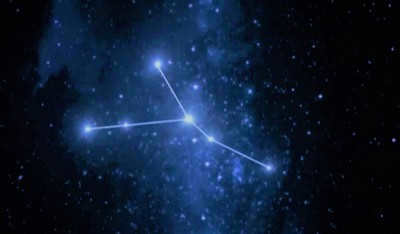

Location and chart of the star grouping
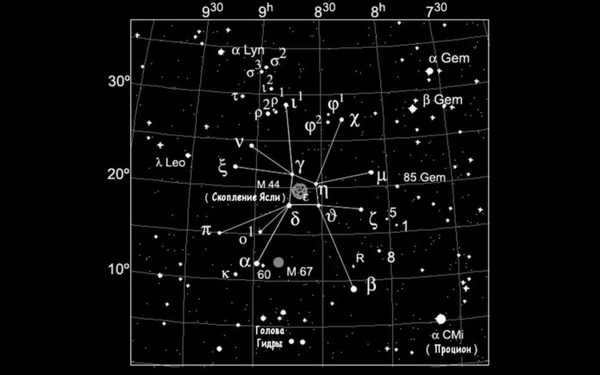
The constellation Cancer is relatively small, ranking 31st in size among other constellations. It covers an area of 506 square degrees in the zodiac. However, there are constellations that are much larger. To locate Cancer in the night sky, one must look towards the second quadrant in the northern hemisphere of the Earth. It is situated between latitudes of -60 to +90 degrees. Nearby, there are other well-known constellations such as Leo, Gemini, Hydra, and Lynx. Cancer is not particularly bright, so it can only be seen on a clear night. Its brightest star, Altrarf, has a magnitude of 3.53, which is relatively dim compared to other stars.
- You can observe the direct rise of Cancer from 7 h 48 min to 9 h 15 min.
- Cancer covers an area of 506 square degrees.
- The optimal time for observing the constellation is from January to February, as Cancer is most visible during this period.
- There are meteor streams called Delta Canciridae in the constellation.
- In Latin (as well as in English), the constellation is named “Cancer” and its abbreviation in astronomical reference books is Cnc.
The primary celestial bodies in the constellation.
1. Acubens serves as the alpha star of the constellation, and it is not a solitary star but rather a binary star system. This system consists of a white dwarf of class A, which serves as the primary star, and a secondary star with a magnitude of 11. The term “Akubens” originates from Arabic and signifies “claw,” which is fitting as it occupies the position of one of the claws in the “star Cancer.” Despite being the alpha star, Akubens ranks fourth in terms of brightness among the primary stars in the constellation.
2. Altrarf represents the beta star of the constellation and is also the brightest star within the constellation. Similar to Akubens, Altarf is not a solitary star but rather a binary star system comprised of an orange giant and a smaller stellar companion. Its name translates from Arabic as “the eye of the Lion.”
3. Astronomers of the Delta constellation have designated another binary star with an extensive moniker – Azellus Australis, which translates to “Southeast Star” in Arabic, while it is also referred to as the “Southern Donkey” in accordance with Roman mythology. Azellus Australis is the second most luminous star in the constellation, following Altrarf. It is composed of a massive orange K-class giant and a smaller star with a stellar magnitude of 12.2.
4. In the Gamma constellation, we find Azellus Borealis, also known as the “Northern Donkey”, which is the second donkey from Roman mythology that aided Bacchus in conquering the swamp. The star system of the “Northern Donkey” comprises as many as three stars.
5. Moving on to the Zeta constellation, we come across Tegmen, which is not just a binary or triple star system, but an entire cluster of five stars.
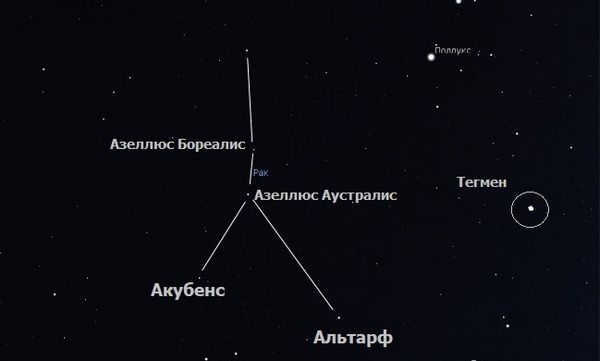
Aside from the aforementioned stars, there are numerous other stars and star systems in the Cancer constellation. However, most of them have low brightness and can only be observed with a professional astronomical telescope.
Other celestial objects
In addition to the stars, the Cancer constellation is also home to star clusters, including:
- The Crèche star cluster (also known as the Beehive), which is listed as number 44 in astronomical directories. The Nursery cluster consists of approximately 200 stars and stands out for being one of the closest clusters to Earth, making it easily visible in the night sky.
- Caldwell-48, a distant spiral galaxy located 56 million light years away, is believed by astronomers to consist of numerous stars and planets, much like our own Milky Way.
- NGC 2500, another spiral galaxy, is slightly closer to us than Caldwell-48, residing at a distance of “only 33 million light-years.”
- NGC 2535 and 2536, two galaxies found in the constellation of Cancer, are of particular interest due to their close proximity to each other. They almost appear as a binary galaxy system, with their gravitational forces mutually affecting one another.
Overall, the constellation of Cancer holds significant importance in scientific astronomical research. It contains both ancient and relatively young star clusters, providing valuable insights into the fundamental structure of the universe.
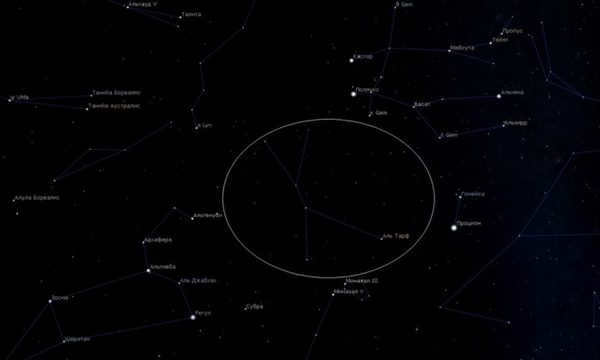
How to Spot the Constellation in the Sky
In order to observe the constellation effectively, it is recommended to equip yourself with binoculars or, even better, a telescope due to its low brightness. Additionally, it is essential to venture outside of urban areas to avoid interference from streetlights.
A straightforward method to locate the Cancer constellation is to first locate its closest neighboring constellations, Leo and Gemini. Cancer will be situated between these two. The best time to view the constellation is during the winter months of January and February.
- The constellation of Cancer is often referred to as the Crab, or simply the celestial Crab.
- In the stellar astronomical catalog, this constellation was introduced during antiquity by the renowned ancient Greek scientist Euclid Ptolemy.
- Out of the 55 stars discovered in the constellation of Cancer, 5 planets have been found to date. It is possible that there are more planets yet to be discovered. Some of these planets may even harbor life, including intelligent life.
- The Tropic of Cancer, located at the northern tropic of the Earth, was named so because it marked the point of the summer solstice 2000 years ago.
While composing the article, my aim was to ensure its utmost uniqueness, usefulness, and quality. I would greatly appreciate any comments or constructive criticism you may have regarding the article. Additionally, if you have any wishes, questions, or suggestions, please feel free to reach out to me via email at [email protected] or through Facebook. Sincerely, the author.
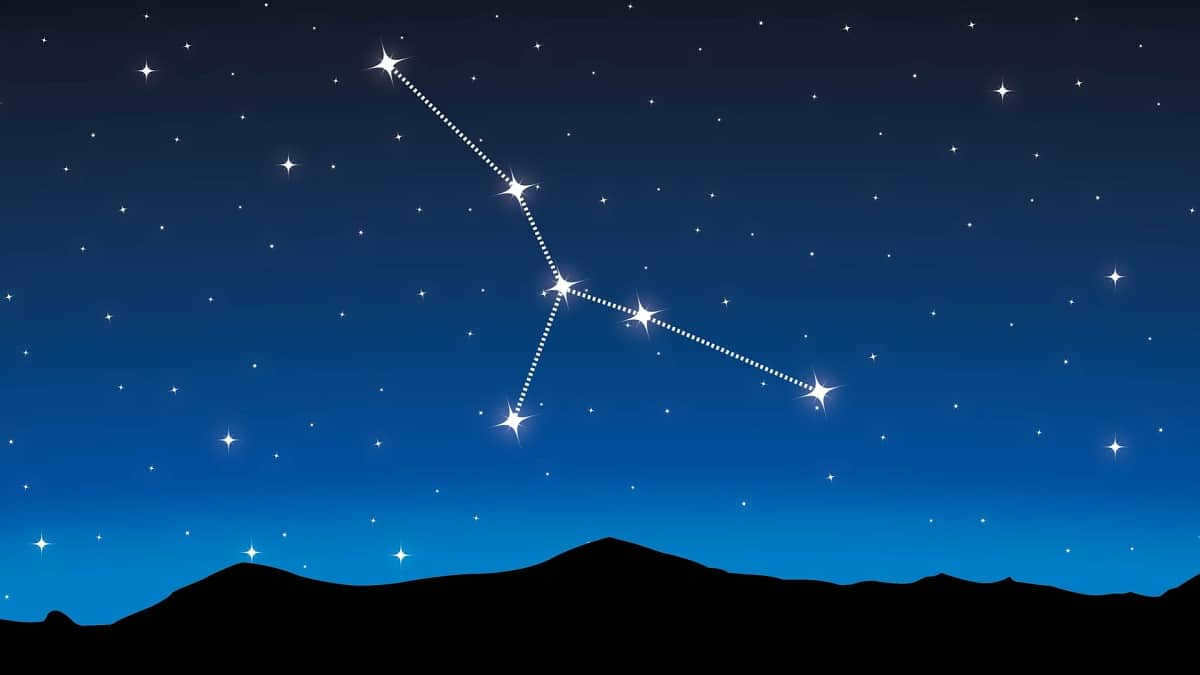
Cancer is a well-known constellation of the zodiac, positioned in the northern hemisphere and holding the 31st rank among the constellations with the largest celestial area, covering a total of 506 square degrees. It can be observed at latitudes ranging from +90° to -60°. within the Cancer constellation. Despite its popularity, locating Cancer in the night sky remains a mystery to many.
This article aims to provide detailed information on the features, origins, and significance of the Cancer constellation.
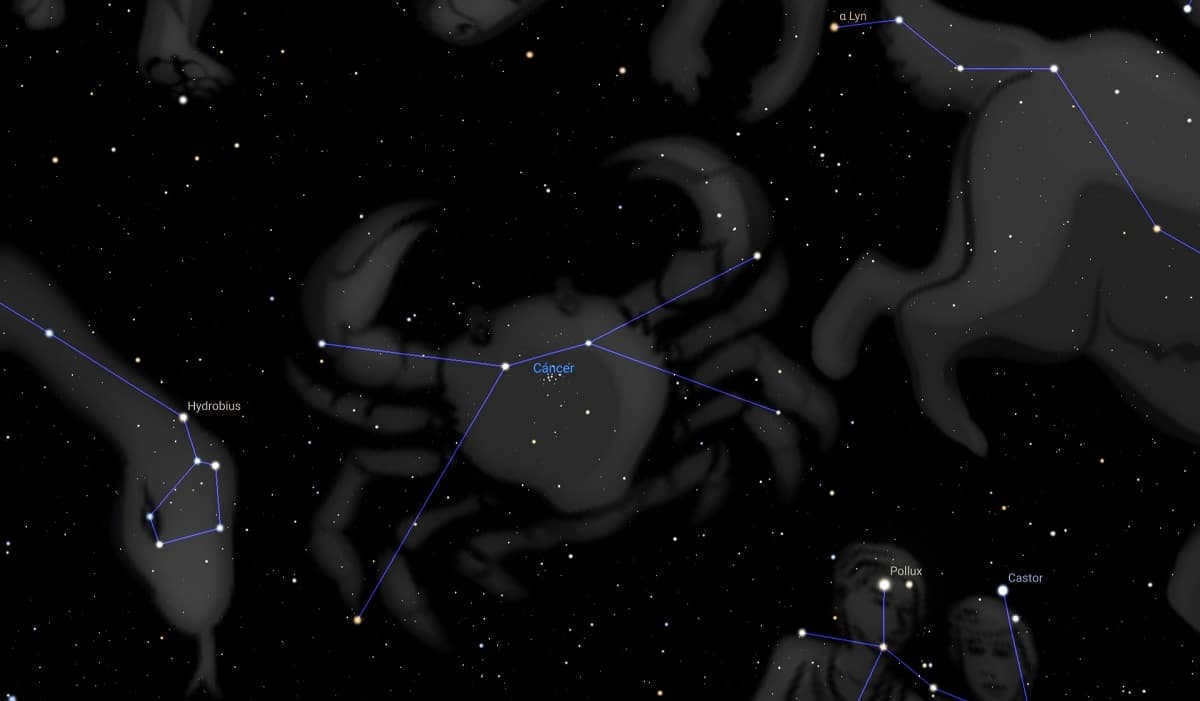
Cancer is unique among the zodiac signs because it is the dimmest. There are no stars in Cancer with a magnitude less than 3. While it may not be particularly large, it does rank 31st out of the 88 constellations. It covers an area of 506 square degrees.
This constellation can be found in the second quadrant of the northern hemisphere and can be seen from any latitude above 60 degrees south. It is surrounded by the constellations Lynx, Gemini, Little Dog, Hydra, Leo, and Little Lion. In the zodiac, Cancer is situated between Leo and Gemini. Astronomers find this constellation fascinating due to the presence of various galaxies and Messier objects.
According to Greek mythology, crabs have a connection with the twelve labors of the hero Hercules. It is said that the goddess Hera, who was Heracles’ enemy, sent a crab to distract him while he was battling the Hydra. However, Heracles managed to defeat both the Hydra and the crab and placed them in the sky as constellations.
In ancient times, the constellation of Cancer marked the location of the summer solstice. However, due to the precession of the vernal equinox, the summer solstice is now found in Taurus.
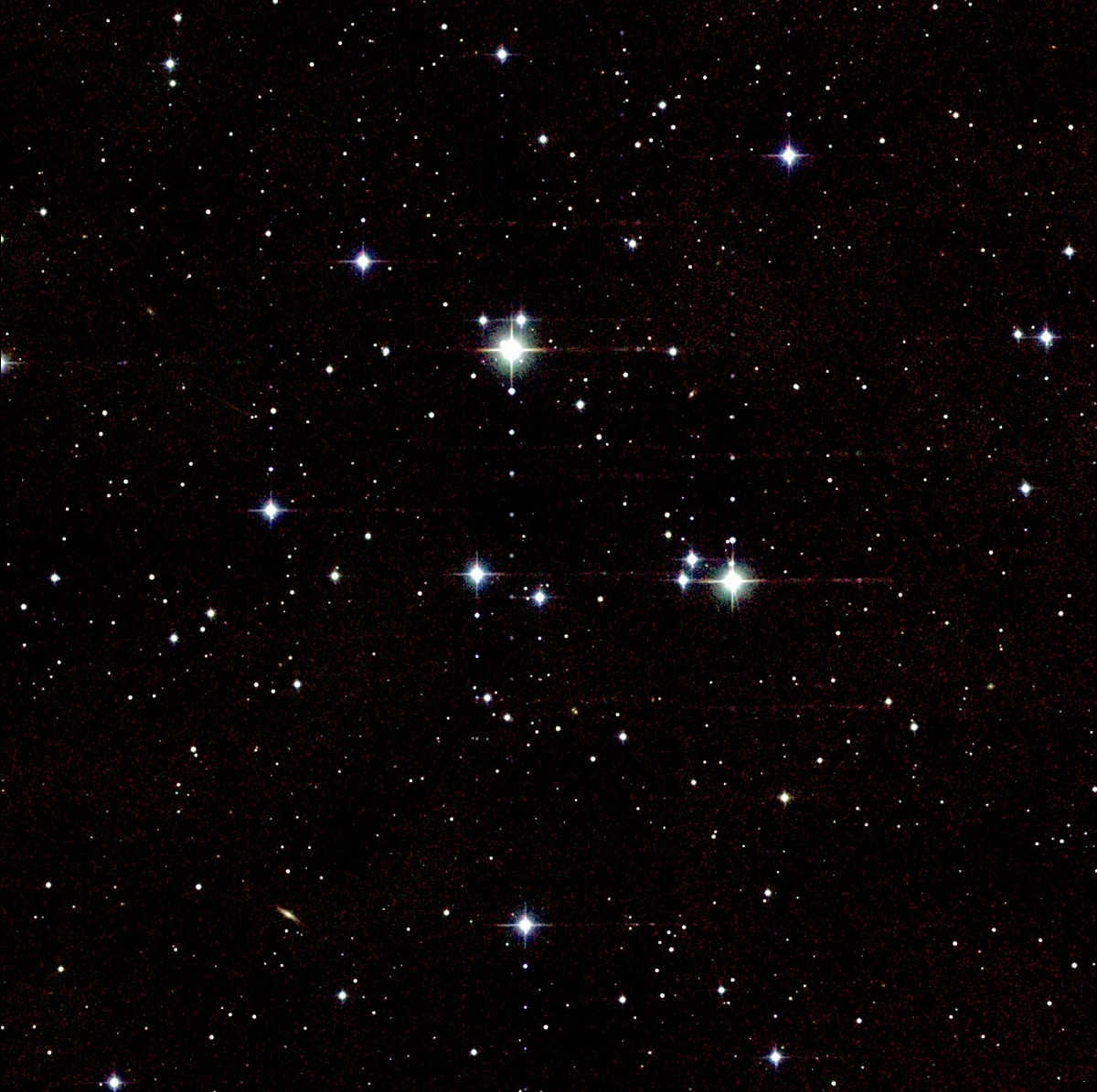
Cancer is a little-known zodiac sign. It does not contain any stars that are brighter than the 3rd magnitude and only has two stars that are brighter than the 4th magnitude. However, there are 104 stars in the constellation that have a magnitude of less than 6.5, making it visible to the naked eye under favorable weather conditions.
Here are some of the most significant stars in the Cancer constellation:
- Alpha Cancer: This star system consists of at least two stars, and possibly three. The primary component is a white dwarf with a magnitude of 4.26, making it the fourth brightest star in the constellation. It is also known as Akubens, which means “crab’s claw” in Arabic. Another name for this star is Sertan.
- Delta Cancri: – A binary star system consisting of two stars, Cancer delta A and Cancer delta B. Delta Cancri A is also known as Asellus Australis, derived from the Latin term for southern donkey. It is situated approximately 180 light-years away from our solar system and possesses an apparent magnitude of 3.94. Due to its proximity to the ecliptic, it occasionally becomes obscured by the Moon.
- Gamma of Cancer: Another star system located 158 light-years away from our solar system, boasting an apparent magnitude of 4.66. Its traditional name is Asellus Borealis, meaning northern donkey. It shares its proximity to the ecliptic with Alpha Raca and Delta Raca, and can be occasionally concealed by the Moon or certain planets.
- Zeta Cancer: also referred to as Tegmine, is in fact a system with multiple stars comprised of at least five celestial bodies. This system is located approximately 83.4 light-years away from our solar system. The first component, known as Zeta 1 Cancri, is a binary star made up of Zeta Cancri A and Zeta Cancri B. Zeta Cancri A is the most luminous star within the cluster, boasting an apparent magnitude of 5.63. The second component is a trinary star system called Zeta 2 Cancri. This particular star system is composed of Zeta Cancri Ca and the binary star Zeta Cancri Cb.
All the other stars in the Cancer constellation have a magnitude higher than five. Notably, there are two stars with planetary systems composed of five planets.
The most fascinating star in terms of scientific research is 55 Cancer. This double star is located 41 light-years away from our solar system and possesses a planetary system with a minimum of five planets. Among these five planets, four are gas giants while one is a carbon planet. Their names are Jansen, Galileo, Brahe, Harriot, and Liebercy.
Additionally, the star HIP 41378 also has a planetary system consisting of five planets. In this particular case, these planets are estimated to have masses ranging from that of Earth to twice the mass of Jupiter.
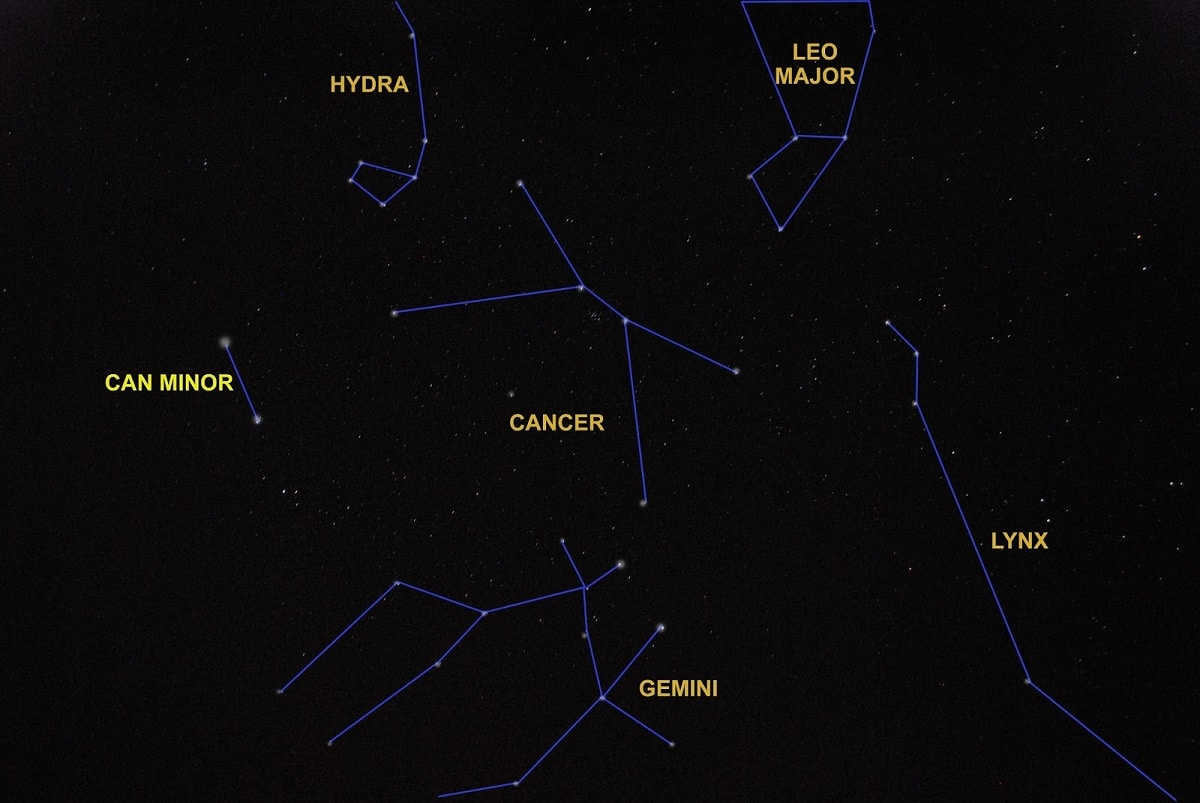
- It is visible in both the northern and southern hemispheres.
- The ecliptic intersects the center of the constellation between late July and early August.
- Cancer is situated 30° north of the Milky Way. Consequently, it is characterized by two stunning star clusters and numerous double stars.
- In the northern hemisphere, it can be observed from late autumn to spring, while in the southern hemisphere, it is visible during summer and autumn and appears in the middle of the night.
- It lacks first magnitude stars, with the stars being quite faint, and the brightest star in the constellation is Altarf, which is 500 times more luminous than the Sun.
- The constellation Cancer does not resemble a crab in the night sky, but rather an inverted “Y”.

